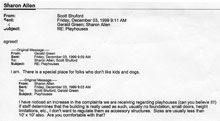Xpress recently obtained a copy of the “book of interpretations”—more than 178 pages of memos, e-mails and handwritten notes that Asheville’s Planning and Development Department uses as a guide when ruling on specific points concerning the Unified Development Ordinance. Some documents in the book date back to the UDO’s creation in 1997.

Former planner Gerald Green, whose name pops up frequently, says the file gradually expanded as city staffers consulted higher-ups about specific points; the answers were saved to avoid conflicts later on—“and to not just sound like someone’s pulling it out of thin air,” Green explains.
That process continues today, reports acting Planning Director Shannon Tuch. While the UDO is meant to cover “generic conditions,” the situations referenced in the “book of interpretation” are more specialized, such as a question that arose about children’s playhouses (which aren’t restricted).
“They come up so infrequently,” Tuch told Xpress. “Oftentimes, these interpretations are made for one, maybe two situations; then that situation doesn’t come up again.”
But for Joe Minicozzi, the mere fact that the city was maintaining such a file unbeknownst to the public was a huge red flag—particularly in light of recent controversies concerning the interpretation of the city’s principal planning document.
“I didn’t even know it existed,” says Minicozzi, who is president of the Coalition of Asheville Neighborhoods board. His first hint came during a March 24 Board of Adjustment hearing, when Tuch named it as a source for her interpretation in a case. “I thought, ‘Where the hell is that book?’” Minicozzi recalls, adding, “I just about had a canary.” After that meeting, he requested a copy of the book via e-mail. Xpress subsequently requested a copy as well.
The problem, he maintains, is that planning code is being written at the staff level rather than being approved by a vote of City Council. But City Attorney Bob Oast says there’s a difference between creating policy and holding discussions among staffers.
Minicozzi says he’s read some of the material and even concedes that it’s a “good book—but it is a good to-do list of [future] UDO amendments.”
Tuch, however, argues that the kind of minutiae that typically lands in the book would only bog down a document that’s already plenty weighty and complex. But staff, she notes, is going through the book to determine whether some questions come up often enough to justify presenting them to Council as potential UDO amendments.
See a selection of key documents from the book at www.mountainx.com/xpressfiles.



It is tough to see how the City Attorney could say it is just “holding discussions among staffers” when the city sights it as evidence at a Board of Adjustment (BOA) hearing.
I think the interpretation at the BOA hearing was that when the UDO says “no parking in the front yard” it really means “you can’t park more than 4 cars in the front yard” Who would have thunk it? I am sure that is what the policy makers meant.
I also learned at the same BOA hearing that when room and board are required all you have to do to satisfy providing board (i.e. meals) is to offer a ride to the grocery store. Wonder if that one will make it into the book of interpretations?